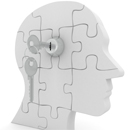
Yes. Pain is literally “all in your head” because your brain must interpret pain in order for you to experience it. However, pain cannot be defined as imaginary because once your brain registers something as painful; it becomes real and no longer illusory.
This brings us to the question: if the pain isn’t imaginary then why is placebo analgesia so effective? The answer lies in expectancy. A recent study published in the Science Translational Medicine Journal, monitored the neural activity of the brain regions involved with the coding of pain intensity, whilst testing the effects of opioid (powerful pain relieving) drugs in individuals with varying degrees of pain relief expectancy. One group was given the opioid without knowing it, the other knew that they were receiving the opioids and were assured that they would experience complete pain relief. The third group was given the opioids but was led to believe that the drugs were not analgesic and on the contrary, that they would actually increase their pain. The positive treatment expectancy that occurred in the group who was given the drugs and told that they would work, resulted in double the pain relief. In contrast, the group who was told that they were given a drug that would make them feel worse; felt no pain relief from the opioids at all.
Different expectancies resulted in the activation of completely different parts of the brain: expecting relief resulted in the activation of a part of the brain known as the endogenous pain modulatory system, while expecting pain resulted in the activation of the hippocampus. The scientists concluded that the most effective pain relief techniques are ones that incorporate a person’s expectations and beliefs into the medical treatment regime.
Another reason why some pain can be misconstrued as imaginary is the fact that some people still experience pain long after their injuries have healed. According to research done at Northwestern University, chronic pain appears to be linked to an old memory trace that basically gets stuck in the prefrontal cortex. The brain remembers the injury as if it were new, and it can’t forget or release it, this is known as the “emotional component of pain.” However, to jump to the conclusion that this type of pain is imaginary would be wrong. Emotional and chronic pain is still registered as pain in your brain; it’s just that the sensation of pain originates in a different part of the brain than the acute sensory pain that is experienced by burning your hand for example. The fact that Vania Apkarian, professor of anesthesiology, at Northwestern’s Feinberg School of Medicine found a drug (D-Cycloserine) that effectively reduces the emotional component of pain, validates the fact that this type of pain is far from illusory and is in fact very real.
The mind and body are intricately connected, and pain is every bit as real whether it originates in the mind or the body. With all of the dangers and side effects associated with pain relieving drugs, perhaps an alternative pain relief method should be utilized; one that involves half the medicinal dose, or perhaps even a placebo, in combination with the creation of a positive pain relief expectancy!